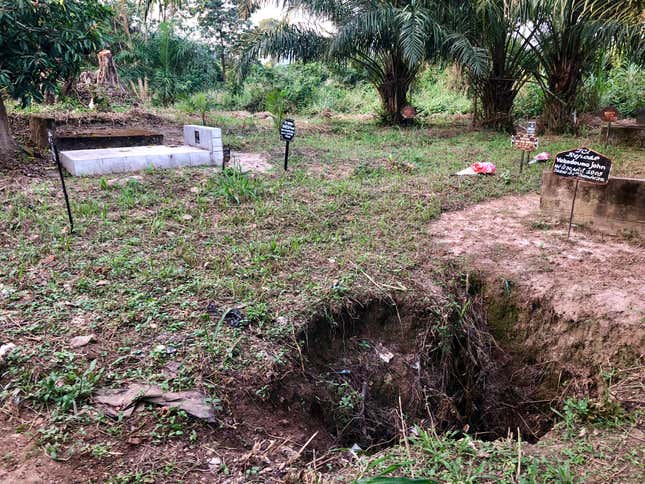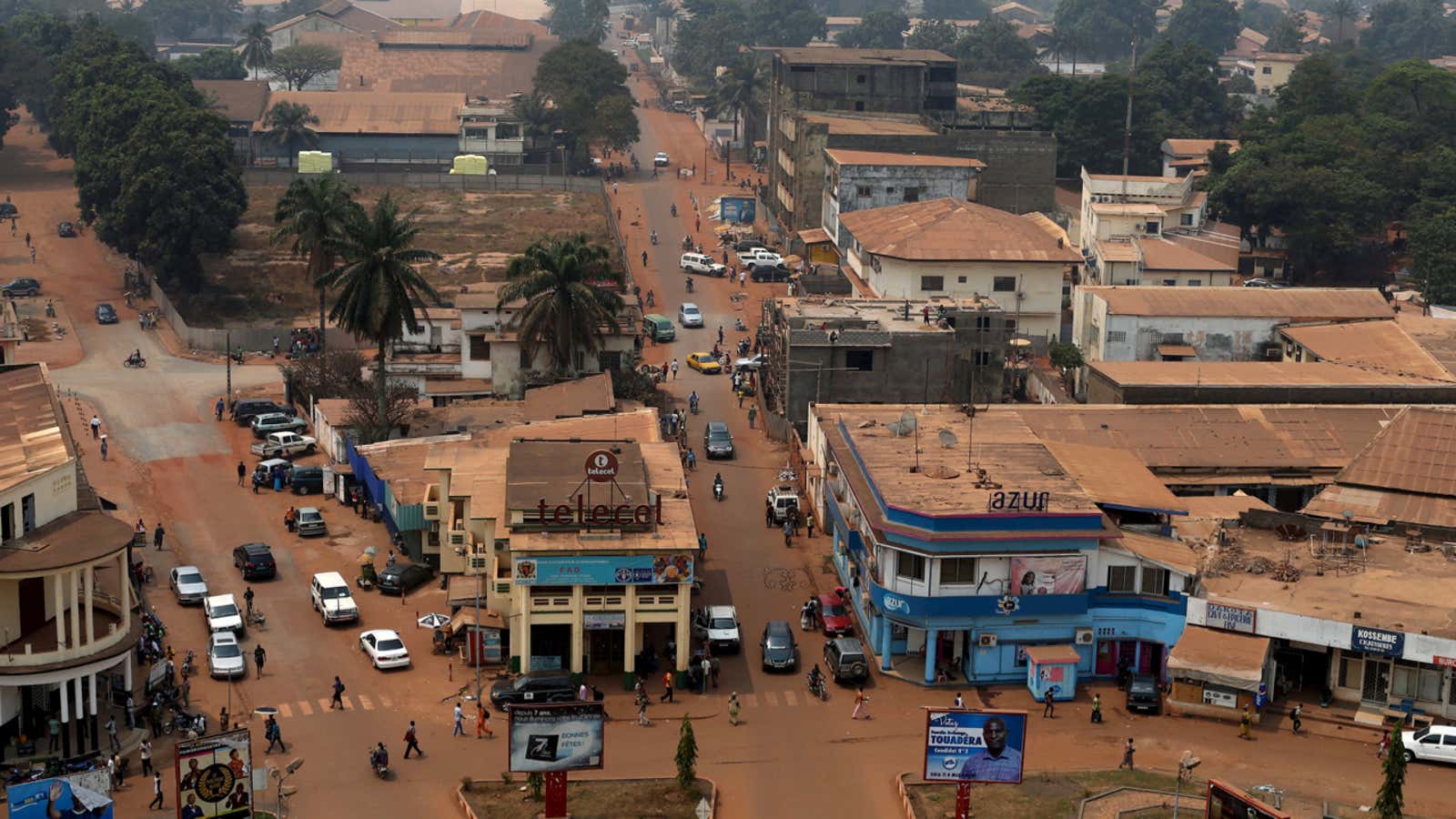On many maps, the Central African Republic is a blank space in the middle of a continent that is already statistically under-represented. The data taken for granted in other countries are unavailable or simply unknown here. A civil war, successive coups, and near-constant violent instability have made data collection seem like an indulgence.
Yet, for a country trying to rebuild, those numbers are desperately needed. Especially, when that rebuilding needs the help of international agencies standing in for basic public services. “Can you imagine a country where nobody knows how many people are here?” said Kobehi Guillaume Toutou, Unicef’s chief of planning, monitoring, and evaluation in the Central African Republic.
Unicef is just one of the international agencies tasked with trying to coordinate national services. With the help of government departments and other agencies, Toutou and his team are about to embark on a Multiple Indicator Cluster Survey, the first of its kind in years. Over the next few months, their agents will visit 11, 000 households with an exhaustive list of questions on health, mortality, sanitation, education, access to media, all for adults and children, via 206 survey indicators.
They’ll enter homes in the city, mud huts with only cloth guarding the entrance on the outskirts, and in many cases, makeshift camps for the thousands of displaced Central Africans who have fled conflicts. While it is not entirely surprising poverty is rife in the Central African Republic, the numbers will give a clearer picture of the lived experiences of Central Africans rather than just applying a wholesale humanitarian response to the crisis.
Primarily, the survey will help authorities establish how many people are living in crisis, how many tents are needed for refugees, how many books for schools and how many vaccines for children.
“Poverty is not just about money,” Toutou says.
Their task is made more arduous by the constant threat of violence in a country that often seems to be on the brink of war. They’ll have to navigate this threat over potholed roads and fly to areas that have never had any roads. A consummate statistician, Toutou rattles off a number: a country the size of France with only 1,385 kilometers (860 miles) of road compares poorly with neighboring Cameroon’s roughy 6,000 kilometers (over 3,720 miles). Electricity and an internet connection remain luxuries.
The count has the added risk of disappearing surveyors, abandoning the task and running off with Unicef’s gear. With violence and insecurity looming again as rebel movements refuse to submit to a central government, who can blame the surveyors?
Births and deaths
The Central African Republic became a nation state when French soldiers “liberated” it from Saharan sultans at the end of the nineteenth century and divided it among French companies to plunder its natural resources. It was already an area raided by slavers and ivory traders, and the French colonial system did little to develop this landlocked country. This legacy of violence and underdevelopment continued after independence in 1960 and CAR went through a succession of military coups and dictators.
The Central African Republic erupted in full-scale civil war in 2013 and 2014, in yet another violent grab for power that divided the country along religious lines, pitting Muslims against Christians. With foreign intervention led by France, full-scale war ended after a year but protracted violence continues as the country’s teeters again on the brink of war.
The number of fatalities resulting from the civil war is still not known. In April 2014, the United Nations estimated about 2,000 deaths, and without the proper tools the government echoed this figure. In September that year, an independent count by the Associated Press found the death toll to be more than twice as high—5,000 people were killed and more than 1 million displaced.

“During the crisis, there were a lot of deaths, people were buried everywhere so we cannot know,” said Alfred Sabendo, deputy director of demography at the Central African Institute for Statistics and Economic and Social Studies, a government agency. Behind him is a tower of brown cardboard boxes and binders that are just part of the backlog of data collection.
Births and deaths are perhaps the most basic data indicator. Even now, in relative peace, it is aid agencies that keep better records. By law, births and deaths are recorded in an outdated centralized system run from the Bangui Town hall, but home births are common, a quick bribe means the dead are buried without the proper certification, while aid agencies run the most functional hospitals. The last census was held in 2003, before the war, when the population was estimated at 3.8 million. Today’s projections are at 5 million, according to the institute.
The Central African Republic is perhaps the worst-case scenario to illustrate the need for proper data collection in Africa. The building blocks for any policy planning, implementation and evaluation are basic figures on population, the economy, the environment and education. Even for countries not teetering on violence, data collection is not prioritized and the data that is available is often inaccurate and unable to keep up with a population boom.
The Count
One of the less dangerous indices to keep track of is the consumer price index, which helps to calculate an economy’s inflation by monitoring a generalized shopping basket (pdf) of everyday goods. Once, sometimes twice a month, a group of interns who hope to get a permanent job with the state statistics agency are sent to markets around Bangui to measure inflation.
Their method is simple, they buy a variety of foods that the average Central African household would eat: salt, wild pumpkin, the staples cassava and plantain, the off-cuts of mutton and beef, smoked wild buck, and as a sweet indulgence, a packet of cold freshly squeezed ginger juice. Skilled artisans sell furniture on the side of the road and enterprising young men use any corner to auction off clothes donated by the west, so food becomes the easiest commodity to keep tabs on.

In the market, vendors are lined up along a slab of concrete that was built to modernize the market, with nothing separating their stalls except an agreement. Some offer an incongruous mix of fabric and bananas, or pyramids of raw eggs sold alongside plastic toys. Despite the bright mid-morning sun, the market is dimmed by the canvass coverings, zinc roofs and a lack of electricity.
Most vendors at the Marché Combattant (meaning the fighting market) in central Bangui specialize in fresh produce process on the spot: women grind peanuts into paste, others chop cassava leaves into thin julienned strips while butchers saw hunks of raw meat, waving away swarms of flies as blood drips into the mud. It’s a typical market scene, except for the plainclothes militiamen, known to extort vendors and ready to cause chaos if they see an opportunity, the counters warn.
In this part of town, it is the Christian anti-Balaka fighters, while elsewhere it could be any number of groups that have sprung up to take advantage of the business of conflict.
In order to monitor prices, the counters have to buy the goods, haggling as any customer would. Then they return to their office in a quieter part of town and weigh each product, compare it to last month’s purchase, and carefully enter the price by hand. At some point, it will be entered into a spreadsheet on one of the few computers in the agency.
Despite their systematic count, the resulting numbers can vary chaotically in just one day. Unpredictable gunfights in the mainly Muslim neighborhood cordoned off by checkpoints, PK-5, could see customers and vendors scatter, and those brave enough to return to the market can push up prices, and overall inflation, explain the counters. The conflict in one part of the city, and the country, has a ripple effect on others, making the price of basic goods exorbitant. The vulnerability to violence increases further away from the capital’s center into the outer suburbs, and towns in the hinterland.
The Danger
In most cases though, the antagonism just bubbling under the surface around the city, and erupting into violence in the rest of the country, creates suspicion, and few people want to participate in any count. It’s also why large parts of the prefecture of Vakaga are missing from the government’s records. Here in the northernmost part of the country, citizens have experienced years of conflict and displacement but little assistance, and would not trust any government official asking questions.
“Some people are simply not interested,” says Sabendo. “They don’t see the results of the surveys in their lives so they simply don’t want to share.”
In order to even enter areas like PK-5 in the capital, agency officials had to pay the heads of each militia group to allow for safe passage and to convince the locals to participate in the survey, he explains. Right now in the central town of Kaga Bandoro violence has broken out, making it a no-go area the agency. People need resources in these areas but resources require data, a dangerous undertaking in the Central African Republic.
“Would you go into PK-5?” asks Sabendo, visibly frustrated.
Armed with little more than a clipboard, a pen and perhaps a calculator, surveyors will have to venture into PK-5 and far worse. The areas that are the most dangerous to enter, villages controlled by rebel groups or towns where the public services have all but collapsed, are the ones desperately in need of emergency aid and basic amenities. In order to rebuild the country, the government and aid agencies need a plan, and for that they need numbers.
Reporting for this story was supported by the International Women’s Media Foundation.
Sign up to the Quartz Africa Weekly Brief here for news and analysis on African business, tech and innovation in your inbox
